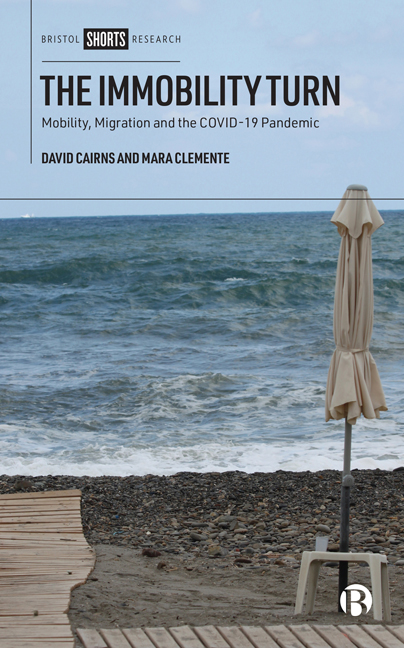Book contents
- Frontmatter
- Contents
- List of Figures
- About the Authors
- one COVID-19 and the Immobility Turn
- two Theorizing the Immobility Turn
- three From Overtourism to Undertourism, and Back Again
- four International Student Mobility and Immobility
- five Maintaining Migration during a Pandemic
- six Mobility after an Immobility Turn
- Notes
- References
- Index
five - Maintaining Migration during a Pandemic
Published online by Cambridge University Press: 18 January 2024
- Frontmatter
- Contents
- List of Figures
- About the Authors
- one COVID-19 and the Immobility Turn
- two Theorizing the Immobility Turn
- three From Overtourism to Undertourism, and Back Again
- four International Student Mobility and Immobility
- five Maintaining Migration during a Pandemic
- six Mobility after an Immobility Turn
- Notes
- References
- Index
Summary
Having looked at the impact of the pandemic on the tourism industry and the mobility of international students, in this chapter we turn our attention towards labour migration. This change of emphasis may appear strange to some readers, with migration traditionally seen as separate from what are considered ‘softer’ forms of mobility. However, while the experience of moving to another country for employment purposes substantially differs from other forms of global circulation, all three of these mobilities depend on the existence of a fully functioning international travel infrastructure and relatively open national borders. We can, therefore, anticipate a certain amount of shared experience among people on the move, even if their experiences are fundamentally different in many other respects.
Another commonality might be the idea of expansionism, discussed previously. As with tourism and student mobility, in the years preceding the onset of the pandemic, levels of labour migration to Portugal appeared to have increased, though not reaching the same levels recorded in other European countries. Residents with a foreign nationality represented around 5.7 per cent of the population residing in Portugal in 2019, rising to 6.4 per cent in 2020 (Oliveria, 2022). This represents a major contrast with, for example, Luxembourg, which had an equivalent figure of 47.4 per cent, and Malta, with 20.1 per cent (Monteiro and Oliveira, 2021). The actual size of the foreign population in Portugal is, however, a difficult issue to assess due to ambiguities within recording systems, although we can say that there has been a growth in the visibility of foreign workers. Also prominent in our evidence are signs of what might be termed ‘periodic migration’, with people travelling to Portugal repeatedly, but for relatively short stays, coinciding with the times during which they were needed by certain sectors of the economy. We might, then, see this as another example of the fractional or fluid migration we discussed in Chapter 4. But again, due to a lack of adequate statistics, we do not really have a precise idea of the scale of such circuitous practices.
Equally difficult to estimate is the exact contribution to the national economy made by labour migrants, although we are aware of the value of these workers to strategically important sectors, including agriculture. Public discourse on migration in Portugal also recognizes the contribution made by these workers to social security, and this is reflected in relevant statistics.
- Type
- Chapter
- Information
- The Immobility TurnMobility, Migration and the COVID-19 Pandemic, pp. 73 - 95Publisher: Bristol University PressPrint publication year: 2023



